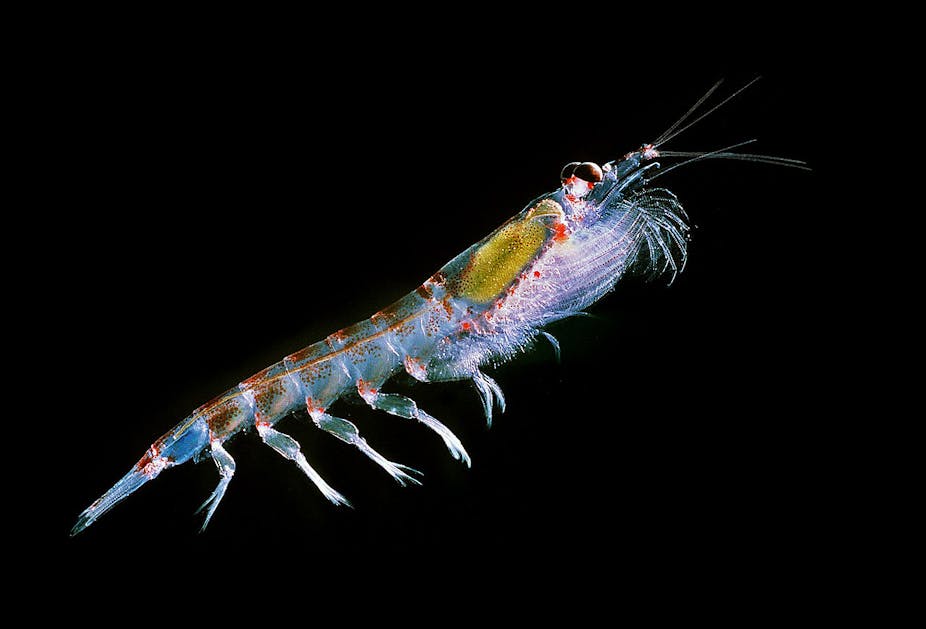Although it is far from the power stations, roads and flight paths of the populated world, the Southern Ocean is already responding to climate change. Average sea temperatures in some parts have risen by about 1°C in 50 years.
This is a significant change for creatures such as Antarctic krill that live within a narrow range of temperatures spanning no more than 6°C. These tiny but abundant crustaceans are perhaps best known as the reason why half a dozen whale species migrate to the cold waters of the Southern Ocean each summer to feed. They are also familiar from their appearance in animated form on the big screen and as krill oil, a health supplement, on supermarket shelves.
A critical part of the Southern Ocean food web, the total biomass (weight) of Antarctic krill is roughly equivalent to that of every adult human on Earth, and every year they produce a similar amount of new material through growth and reproduction.
This incredible production sustains the diverse array of charismatic marine predators that people commonly associate with the Antarctic: whales, seals, penguins and albatrosses, for example. None of these species feeds exclusively on Antarctic krill but it is often their main prey, and an important food source for many less well known species of fish and sea-bed invertebrates.
The current generation of climate projections suggest that Southern Ocean warming will continue throughout the 21st Century under all but the most optimistic scenarios. How will this warming affect Antarctic krill and the important food web that it supports? In a recent paper published in the journal PLoS One, my co-authors and I have begun to answer this question by focusing on the potential consequences for Antarctic krill growth. Growth is a useful indicator of habitat quality: when small animals can no longer grow, something must be wrong.
Marine ecologists collected Antarctic krill from different parts of the Southern Ocean and observed their growth rates aboard a research ship. They derived an equation that described the relationship between these observed growth rates and the temperature and food availability in the waters that the krill were taken from. We applied this equation to the current generation of sea temperature projections to assess how Antarctic krill growth rates might change between now and the final decades of the 21st century. Our study focused on the area between the Greenwich Meridian and 90°W, historically known as the Weddell Quadrant, and centred around the Scotia Sea. This is where the highest concentrations of Antarctic krill and its predators occur.
Our results suggest that the effects of warming could reduce growth habitat, the area that supports Antarctic krill growth, by a fifth. That is, by about 1.2 million km2, an equivalent area to France and Spain. Antarctic krill growth rates in the remaining habitat could also be reduced by a fifth. These effects are unlikely to be evenly spread out, and results suggest that the most serious habitat loss will be concentrated in the northern half of the Southern Ocean, where temperatures are warmest.
This includes the waters around the island of South Georgia, home to 95% of the world’s Antarctic fur seals, 30% of its Macaroni penguins, and substantial populations of other penguins and seabirds. These species are busy rearing offspring during the few summer months when krill can grow. The penguins and seals forage close to the island and return regularly to the shore to feed their young. A reduction in the available supply of Antarctic krill could have particularly severe consequences for the wildlife of South Georgia.
This type of study is a form of risk assessment. It uses available knowledge to produce a best estimate of potential outcomes. Change in the Southern Ocean is driven by the naturally extreme climate, the repercussions of the massive removal of whales during the 20th century, and the effects of human-induced climate change.
It is difficult to definitively attribute any observed change to a particular cause and it is impossible to predict the future with certainty. Nonetheless our study follows others which suggest that human-induced acidification and sea-ice loss could also affect Antarctic krill populations. This mounting evidence suggests that the Southern Ocean, far from being a haven from climate change, is likely to be severely affected.

